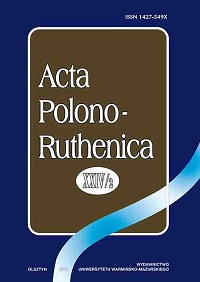Українсько-польські паралелі в системі фразеологічних біблеїзмів
Ukrainian-Polish Parallels in System of Phraseological Bibleisms
Author(s): Tetjana KosmedaSubject(s): Language and Literature Studies, Foreign languages learning, Studies of Literature, Translation Studies
Published by: Wydawnictwo Uniwersytetu Warmińsko-Mazurskiego w Olsztynie
Keywords: theolinguistics; bibleism; phraselogism; degree of equivalence; semantics; pragmatics
Summary/Abstract: At the end of the ХХ and the beginning of the ХХІ century an intensive development of theo-linguistics can be traced as a direction of linguistics, which aims at the investigation of the relation between language and religion. A theonym is considered to be the main unit of theolinguistics, and bibleism is considered to be its variety. Phraseologism – the main form of the structural expres-sion of bibleisms – is considered to from the point of its wide linguistic understanding. Nowadays the formation of an international bibleisms-phraseologisms can be traced and have a specific ex-pression in Ukrainian and Polish linguo-cultures. The above mentioned phenomenon has got its reflection in the Concise Ukrainian-Polish Dictionary ofSetExpressions: Equivalent Words, Phraseologisms, Proverbs and Sayings (compilors: T. Kosmeda, O. Gomenyuk, T. Osipova, 2017), and was the first one in the history of Ukrainian-Polish Phraseology. The character, the types and the degree of equivalence of the fragment of Ukrainian-Polish phraseological units have been analyzed. The degree of equivalence includes the bibleisms, which are fixated in the above mentioned dictio-nary (75 units). It has been revealed that the Ukrainians and Polish expressions are the product of two related Slavic languages that have got many things in common in the system of the bibleisms-phrase-ologisms. Under conditions of similar semantics we may trace some formal differences caused by variation and optional components of the structure of phraseologisms and a non-correspondence of their grammatical forms and syntactic structures in general, etc. Not full equivalents can be traced as well, and were caused by semantics non-correspondence (it can be wider or narrower and rarely absolutely non-equivalent or homonymic) and pragmatics (the presence of polar axiology, unequal stylistic parameterization).
Journal: Acta Polono-Ruthenica
- Issue Year: 2/2019
- Issue No: XXIV
- Page Range: 139-150
- Page Count: 12
- Language: Russian

